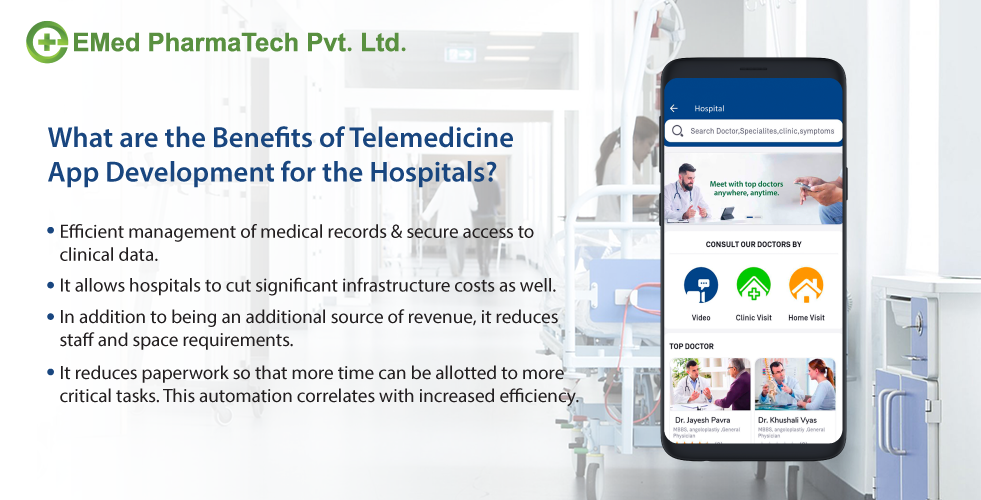In the not-so-distant past, we had no option but to visit the hospital if we feel sick. Notwithstanding how many difficulties one may face in traveling if the patient wanted to see a doctor, they must go to the doctor. Then an almost utopia-like idea of Telemedicine came along, wherein people could consult with the doctor from their smartphones, eliminating the need for traveling. This remote consultation with the doctor is facilitated by telemedicine app development.
What is Telemedicine App Development?
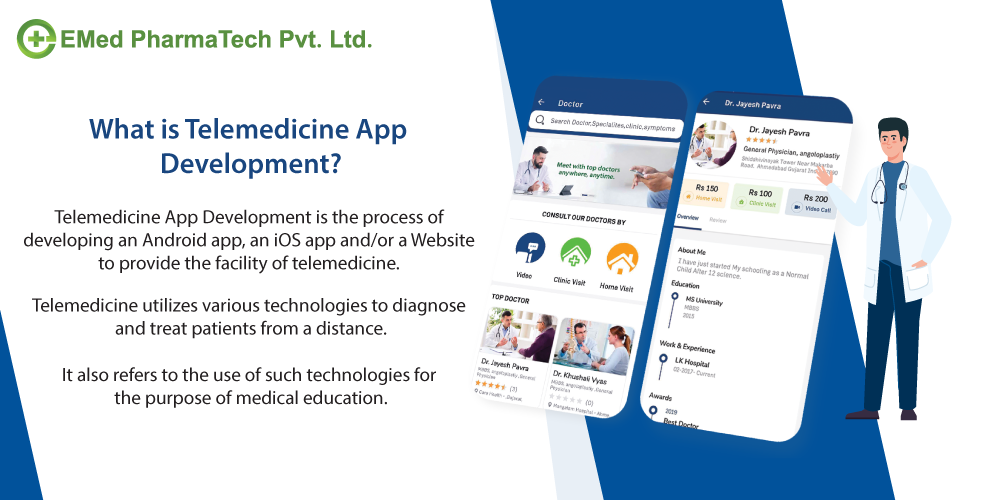
Telemedicine app development is the process of developing an Android app, an iOS app, and/or a Website to provide the facility of telemedicine. Telemedicine utilizes various technologies to diagnose and treat patients from a distance. It also refers to the use of such technologies for the purpose of medical education.
Telemedicine is a part of Telehealth:
It is important not to confuse Telemedicine with Telehealth. Telehealth is an all-encompassing term that includes most digital health solutions like Telemedicine, Remote Patient Monitoring, Telemonitoring, etc.
Telemedicine refers to the platform that enables the interaction between doctor and patient. Telemedicine is strictly used in clinical practices, whereas Telehealth is used for clinical as well as non-clinical administrative services. Patient training, use in academia, usage of various sensors, etc., fall under this category.
Brief History of Telemedicine:
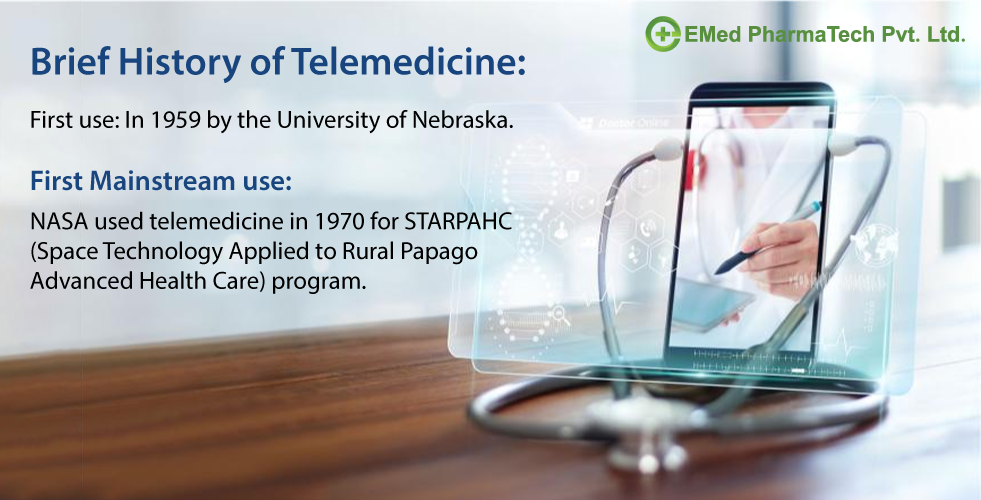
The wide adoption of telemedicine is fairly recent; its advent is not so new. The first use of Telemedicine, although not so advanced, dates back to as far as the 1960s.
The first documented use of telemedicine is that of the University of Nebraska in 1959. The university’s clinicians set up a two-way television transmission to transfer information and later linked it with a hospital to conduct video consultations. After this first successful demonstration, NASA partnered with Lockheed to provide telehealth services to astronauts in space. This partnership lasted till 1970 and resulted in STARPAHC (Space Technology Applied to Rural Papago Advanced Health Care) program.
Over the past few decades, Telemedicine is gradually advanced and has been used sparingly. Fast forward to today, over 90% of healthcare providers submit that their organizations have a working telemedicine app or they are developing it.
Why is everyone talking about Telemedicine now?
Telemedicine is now the talk of the town, and there are many reasons behind that. Watch is this video to know the reasons why do you need Telemedicine?
With the help of advanced tools & services, telemedicine app development is revolutionizing the healthcare industry by reducing gaps in healthcare. It provides uninterrupted communication between the patient and the doctor.
This is the perfect time to implement a Telemedicine app in your hospital or clinic as demand is still growing, and it is expected to grow even further. What is this video on how to implement Telemedicine?
But why now?
COVID-19 massively restricted people’s movement, and thus it was necessary to provide attention to care from a distance. This allowed healthcare providers to expand their service coverage.
The forecast for telehealth from the year 2014-22 can be seen here.
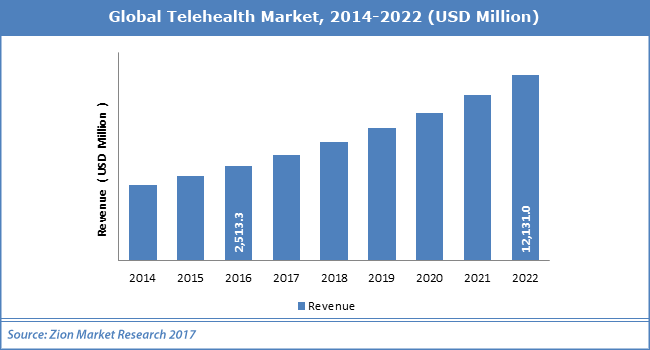
A report from Market Research Future forecasts the growth of the telemedicine market at a CAGR of 16.5% till 2023. The latest report from Global Market Insights report predicts the telemedicine market valuation at $130.5 billion by 2025 from the present valuation of $38.3 billion. Read this blog to know how Telemedicine plays a significant role in healthcare as well as global market growth.
Which Technologies are Used in Telemedicine App Development?
Telemedicine incorporates many advanced technologies to deliver high-quality care. The programming part needs different technology combinations for the front-end, back-end, database, data management, and communication. It requires an additional mechanism to add integrations like 3rd party payment gateways, EHR, HMS, ERP, EMR, etc.
The detailed discussion of technologies used for making a successful telemedicine app development entails a blog of its own, so let us quickly go through the widely used technologies for designing the software.
Telemedicine Programming Architecture:
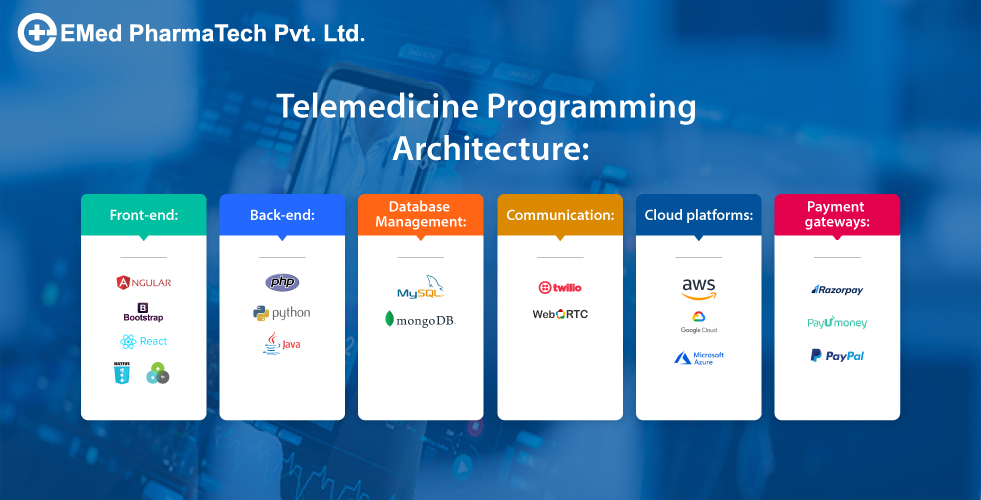
- Front-end: Angular, React, Bootstrap 3, Native Apps, Cross-Platform Apps
- Back-end: PHP, Python, Java
- Database management: Mysql, MongoDB
- Communication: Twilio, WebRTC
- Cloud platforms: Amazon Web Services (AWS), Google Cloud, Microsoft Azure.
- Payment gateways: Razorpay, PayUMoney, Paypal
Tips:
- Choose frameworks that are compatible with multiple platforms so that your app runs smoothly on Android, iOS, and the Web. This is vital to serve a broader user base.
- Design your app keeping users in mind. Stuffing unnecessary extra features overwhelms the user and spoils the user experience.
- Add integrations with wearable devices to gather real-time health data.
Trending Technologies in Telemedicine App Development:
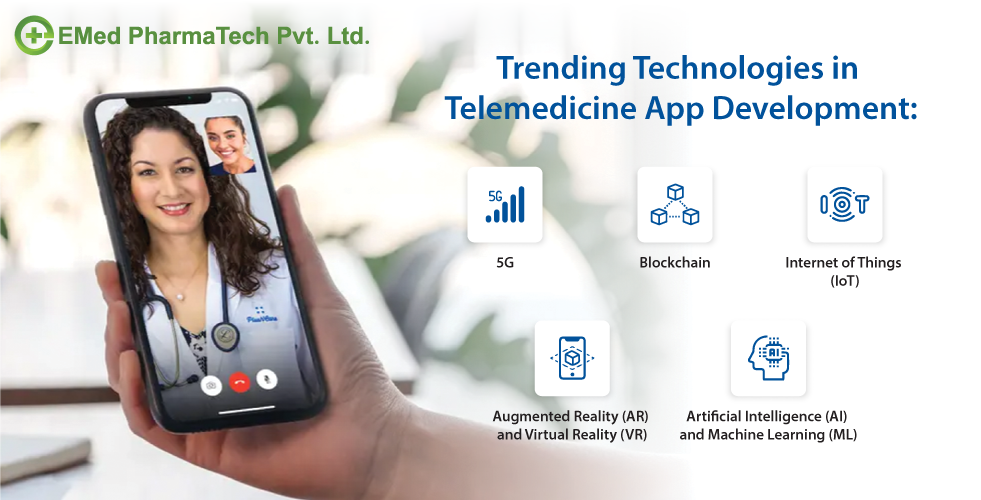
We just skimmed through the list of programming languages, frameworks, and other gateways. Now let us look at the trending core technologies that are widely used in Telemedicine App Development.
- 5G: The fifth generation of cellular connectivity provides high-speed internet and higher bandwidth at lower latency, ideal for providing uninterrupted video connection. Their specification sheet shows a top speed of around 20 Gbps per mobile base station. These faster speeds allow doctors to use 4k resolution webcams that provide a crystal clear view of the patient remotely. Such high-quality virtual consultation makes it feel like a traditional in-person visit.
- Blockchain: Blockchain defends critical patient data against hackers. The distributed ledger technology coupled with private keys and encoding can secure patient records and optimize the healthcare supply chain.
- Artificial Intelligence (AI) and Machine Learning (ML): Cutting-edge data-driven technologies like AI and ML learn or improve from examples and try to mimic human decision-making. They have the potential to reduce and even eliminate the likelihood of disease by enhancing early diagnosis. AI and ML improve by analyzing large databases like patient medical history, and medical data. Read about how AI plays a vital role in healthcare services.
- Augmented Reality (AR) and Virtual Reality (VR): AR and VR programs have the potential to advance medical imaging and healthcare outcomes, and that’s why they are hailed as the next big thing in telemedicine. It has the potential to improve healthcare outcomes by 30-40%. To understand why AR and VR are termed the future of telemedicine, watch this brilliant video.
- Internet of Things (IoT): IoT is a network of physical devices running on the internet. It utilizes computer chips and electronic sensors to monitor devices collecting and sharing data wirelessly. It is crucial to transmit data from the devices wirelessly in real-time, allowing healthcare professionals to know whether there is a need for urgent medical attention.
By utilizing all these promising technologies, telemedicine can scale more heights and improve the healthcare landscape by reducing the overall cost, improving the quality of care, and more.
Advice: Let your telemedicine platform evolve with time by using these technologies.
Impact of Telemedicine:
The inception of telemedicine holds many promises in solving various healthcare challenges faced by both patients and doctors. Telemedicine has boosted the accessibility of healthcare globally, and thus the adoption of mHealth apps.
mHealth Adoption: Increased adoption of mHealth apps allows users to self-management their overall wellness, including disease prevention and management.
The total number of active mHealth apps available to users is now more than 1,65,000. The uses of mHealth apps are many. They can be used to provide information to patients in text, audio, or video formats, remind patients, record their health conditions, or provide guidance for further diagnosis.
Globalization: There’s no denying the fact that telemedicine has truly globalized healthcare. A patient sitting in one corner of the world can interact with the doctor sitting in the opposite corner of the world provided they both have a reliable internet connection. Thus telemedicine has removed barriers to accessing healthcare by removing constraints of geographical boundaries.
Types of Telemedicine:
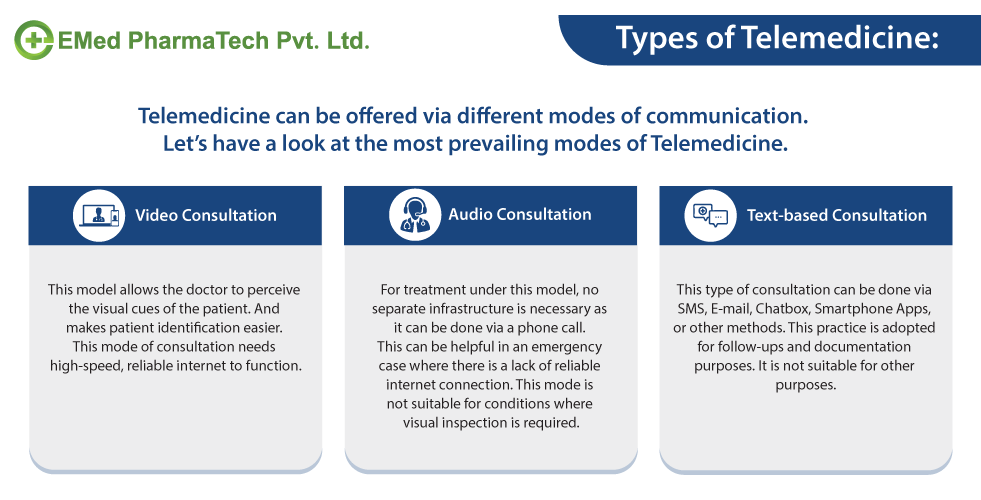
Telemedicine can be offered via different modes of communication. Let’s have a look at the most prevailing modes of Telemedicine.
- Online Consultation:
In this mode, Patients can connect with the doctor virtually for medical consultation. There is no need to step outside for that. It is further divided into three categories.
- Video Consultation:
This model allows the doctor to perceive the visual cues of the patient. And makes patient identification easier. This mode of consultation needs high-speed, reliable internet to function.
- Audio Consultation:
For treatment under this model, no separate infrastructure is necessary as it can be done via a phone call. This can be helpful in an emergency case where there is a lack of a reliable internet connection. This model is not suitable for conditions where visual inspection is required.
- Text-based Consultation:
This type of consultation can be done via SMS, E-mail, Chatbox, Smartphone Apps, or other methods. This practice is adopted for follow-ups and documentation purposes. It is not suitable for other purposes.
What are the Benefits of Telemedicine App Development for all stakeholders?
The adoption of telemedicine benefits all the stakeholders involved, whether you are a doctor, a patient, or you run a hospital.
Let us briefly look at the benefits offered by telemedicine for patients, doctors, and hospitals.
Telemedicine App For Patients:
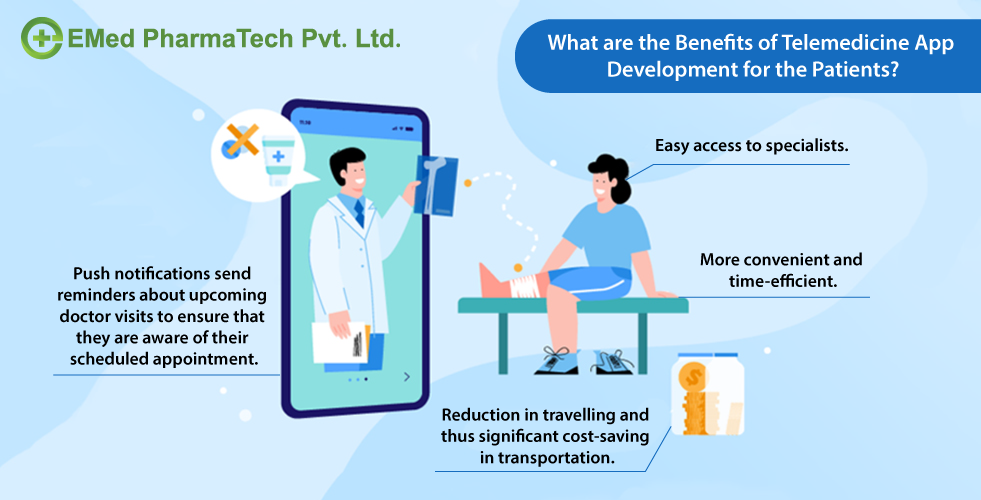
- Easy access to specialists.
- More convenient and time-efficient.
- Reduction in traveling and thus significant cost-saving in transportation.
- Push notifications send reminders about upcoming doctor visits to ensure that they are aware of their scheduled appointment.
Telemedicine App For Doctors:
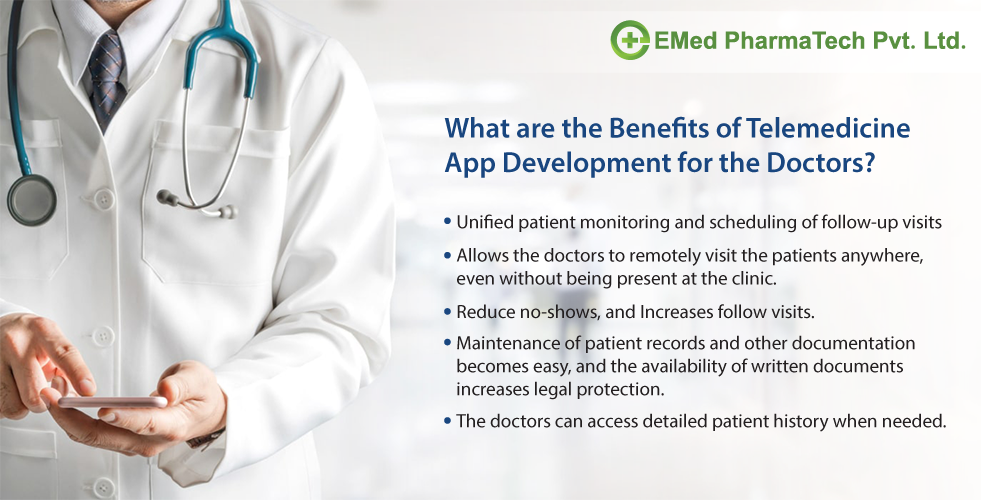
- Unified patient monitoring and scheduling of follow-up visits.
- Allows the doctors to remotely visit the patients anywhere, even without being present at the clinic.
- Reduce no-shows, and Increase follow visits.
- Maintenance of patient records and other documentation becomes easy, and the availability of written documents increases legal protection.
- The doctors can access detailed patient history when needed.
Telemedicine App For Hospitals:
- Efficient management of medical records & secure access to clinical data.
- It allows hospitals to cut significant infrastructure costs as well.
- In addition to being an additional source of revenue, it reduces staff and space requirements.
- It reduces paperwork so that more time can be allotted to more critical tasks. This automation correlates with increased efficiency.
Highlights of Pros and Cons of Telemedicine:
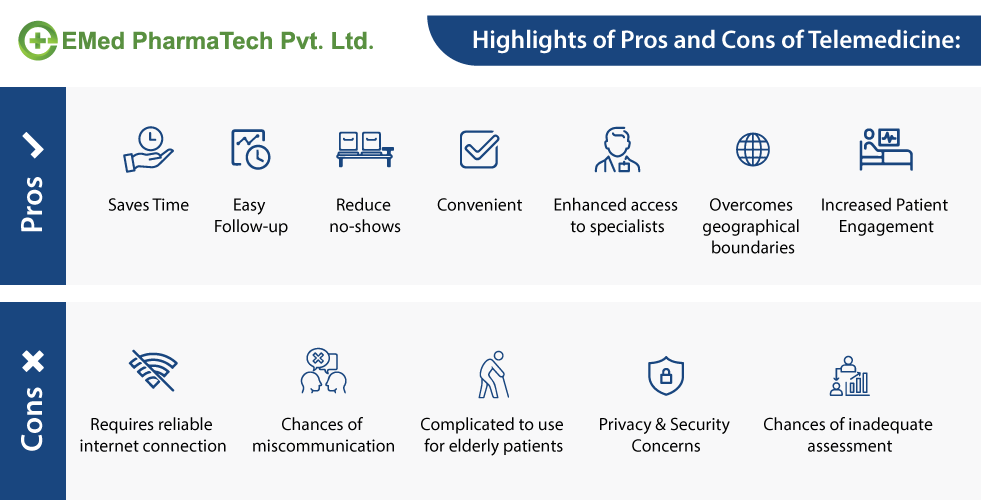
What features does a successful Telemedicine App Development require?
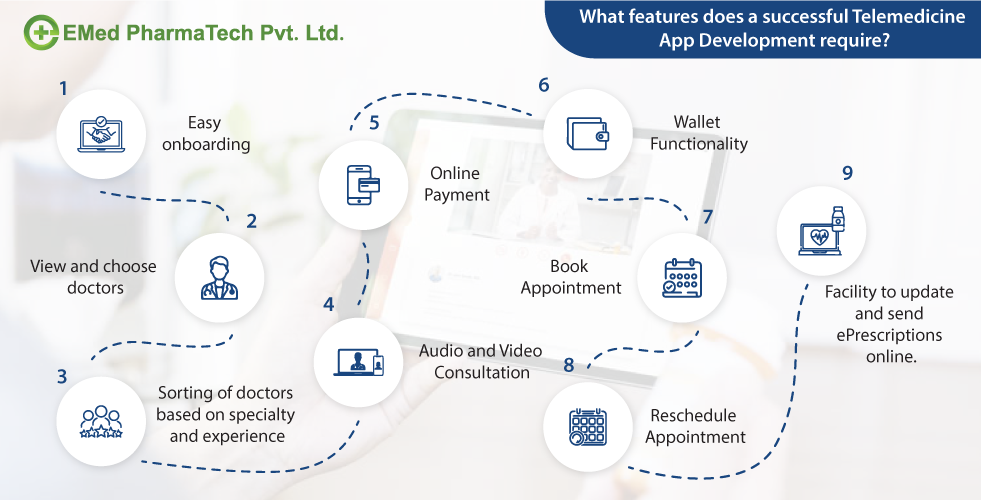
- Easy onboarding
- View and choose doctors
- Sorting of doctors based on specialty and experience
- Audio and Video Consultation
- Online Payment
- Wallet Functionality
- Book Appointment
- Reschedule Appointment
- Facility to update and send medicine orders online.
What are the challenges of Telemedicine app development?
Although the challenges faced during the project implementation depend upon circumstances, many challenges are common for most telemedicine app development projects.
- Determining a technology stack and level of functionalities
- Ensuring compliance with security standards
- Ensuring the privacy of users and confidentiality of data
- Robust measures to EHR without compromising usability
- Good back-end architecture to handle critical data
- Even after the implementation, training staff members to use it can also be challenging
How to Build a Telemedicine Platform?
Successful telemedicine app development involves many steps, and every stage requires decision-making.
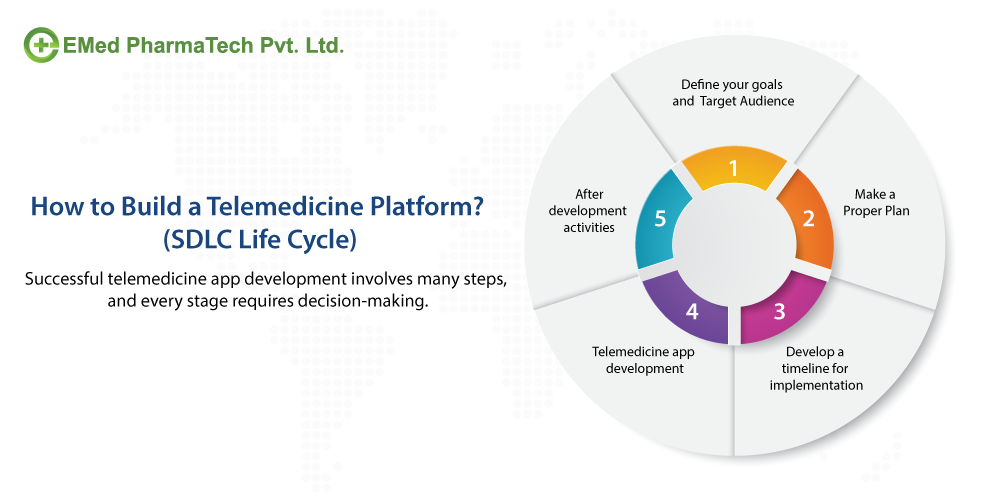
1. Define your goals and Target Audience:
Is there a better question to ask yourself than asking what you want to achieve with this app development? You need to define for whom you are planning to develop this app (i.e., target audience); why are you doing this? (i.e., your purpose and goal), from where will you finance this development endeavor? (i.e., identifying revenue streams).
Asking these types of questions ensures that your goals are always aligned with your expectations.
2. Make a Proper Plan:
The significance of laying out a proper plan or strategy can never be overstated. The right plan ensures that you have a clear vision from the initiation till the end.
3. Develop a timeline for implementation:
Make a tentative timeline for various stages of the project. Allot adequate time to the components of your business plan and prioritize more important ones.
4. Telemedicine app development:
Now that your business plan and timeline are ready, it is time to decide whether you have the required expertise for in-house telemedicine app development or you want to hire a Telemedicine platform developer.
If you do not have a competent internal IT team, complying with the rules and regulations will be tough. That is why it is recommended to outsource your platform development work; if this is not possible, consult with a healthcare IT consultant.
How to choose the most suitable app developer?
If you decide to go with telemedicine app developers, there are certain points you should keep in mind. To ensure that you find the most suitable development partner, keep the following points in mind:
- Firstly, see the features offered by all the alternatives and decide which one suits your requirements most closely.
- Specify what kind of technical support you are getting throughout the project duration.
- Ensure HIPAA (Health Insurance Portability and Accountability Act) compliance.
- Check the traffic handling capacity and scalability of the platform.
- Check the usability of the platform.
- Clarify the timeline for development, testing, and deployment. Get the project's total cost, including one-time fees and recurring costs, and see whether it is in line with your estimation.
- Ensure they have the best data handling policies and use the latest technology.
Tip: Analyze the pros and cons offered by all the alternatives.
5. After-development activities:
After the platform's successful deployment, it needs to be monitored regularly to ensure its good performance in the long run. Frequent assessment of the platform - both financially and performance-wise is necessary to get an overall idea about its usability for your organization.
Read this comprehensive step-by-step guide on how to implement telemedicine in your hospital or clinic.
Developing telemedicine and conducting performance audits and assessments after the app development is a tough task and requires a good amount of time and attention. Keeping in mind that the healthcare providers are already busy with other administrative tasks, they are unable to allocate human resources throughout the project deployment. That is where outsourcing telemedicine to a third-party vendor comes into play - it takes that weight off their shoulders while enhancing the quality of the platform.
Currently, 64% of IT leaders outsource mobile app development. According to a report, the IT outsourcing market's cumulative contract value will grow to over USD 409 billion by 2022.
Benefits of Outsourcing Telemedicine Development:
Outsourcing your Telemedicine App Development allows you to benefit from other companies' domain expertise while keeping full oversight of the project. You can utilize their experience by getting additional knowledge, strategies, and insights throughout the project's deployment.
Another reason why most people prefer to outsource telemedicine app development is that it reduces project costs and gives you a competitive edge by fast-tracking your project. By choosing to outsource your project, you can save time and money, get exposure to expert talent, and you can focus on the day-to-day operations of your clinic.
Also, read How Telemedicine Helped in Times of the Pandemic? check out this link.
_POST_1617701385.png)
